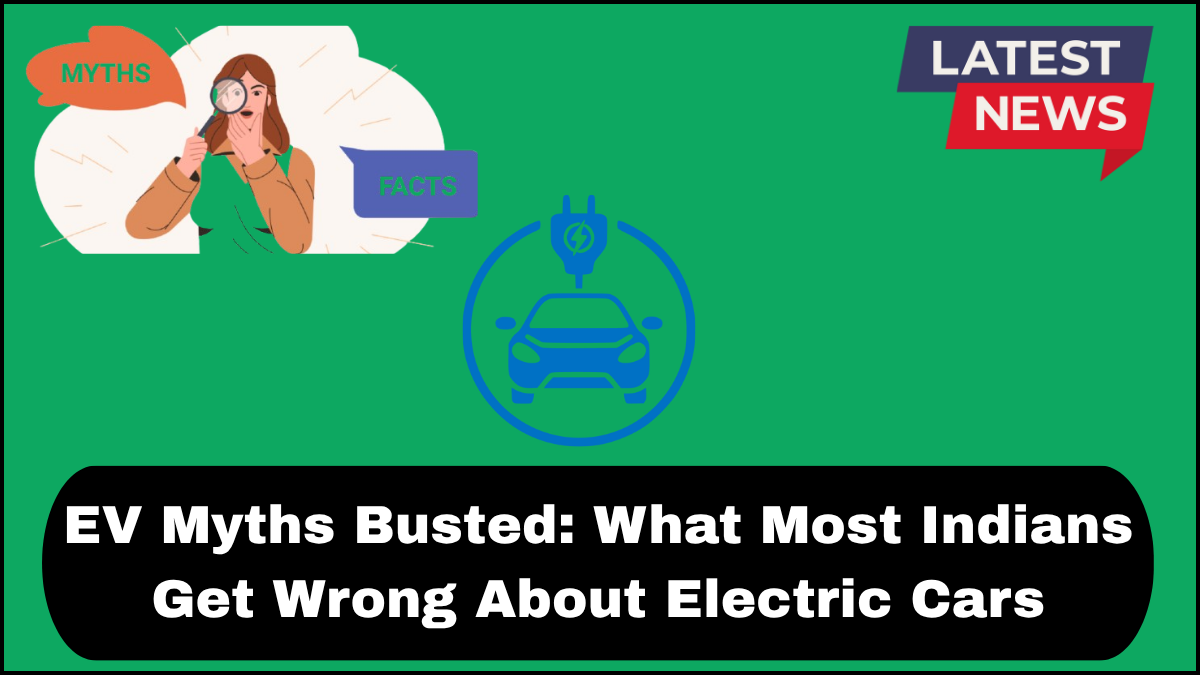Electric vehicles (EVs) have taken center stage in India’s push toward sustainable mobility. However, myths and half-truths still cloud public perception, slowing down adoption. In this guide, we’ll set the record straight by busting the most persistent EV myths in 2025—and explain what’s really going on under the hood. If you’re still on the fence about electric cars, it’s time to rethink the common misconceptions that might be holding you back.

Myth 1: EVs Can’t Handle Long Distances
Reality:
One of the biggest common misconceptions is that EVs are only good for city commutes. In truth, modern EVs like the Tata Nexon EV, Hyundai IONIQ 5, and MG ZS EV offer ranges of 300–500 km on a single charge. For context, that’s more than enough for most weekend road trips or intercity travel.
What’s more, India’s highway infrastructure is rapidly evolving. The number of high-speed EV charging stations along national highways is growing fast, backed by government and private investments. In 2025, a road trip from Delhi to Jaipur or Mumbai to Pune in an EV is not only possible—it’s practical.
Myth 2: EVs Are More Expensive Overall
Reality:
Yes, upfront prices are higher than equivalent petrol or diesel cars. But this view ignores the total cost of ownership (TCO). With fewer moving parts, EVs require less maintenance. No oil changes, fewer brake replacements, and lower running costs (electricity is cheaper than petrol) make a big difference over five years.
Also, government subsidies like the FAME-II scheme and state-level incentives in Maharashtra, Delhi, and Gujarat can slash the price significantly. When you factor in reduced fuel and service bills, EVs often come out cheaper over time.
Myth 3: Charging Takes Too Long and Is Inconvenient
Reality:
This myth might have had legs a few years ago—but EV myths busted in 2025 tell a different story. Most EV owners charge their cars at home overnight, just like a smartphone. For those in apartments or on the go, fast-charging infrastructure has dramatically improved.
Fast chargers can now top up an EV from 10% to 80% in 30–60 minutes. Public charging stations are being installed in malls, parking lots, petrol stations, and office buildings across metro cities. Apps like Tata Power EZ Charge, Ather Grid, and Statiq make it easy to find and reserve a charging slot.
Myth 4: EV Batteries Don’t Last Long in Indian Conditions
Reality:
Battery degradation is a valid concern—but it’s often overstated. Most modern EVs come with 8-year or 160,000 km warranties on the battery. Indian automakers test EVs rigorously for heat, dust, and humidity before launching them locally.
New battery chemistries (like LFP and NMC) have also improved thermal stability. Additionally, active thermal management systems protect battery health during hot summers and long drives. With proper care, EV batteries can last as long—if not longer—than combustion engines.
Myth 5: EVs Aren’t Really Eco-Friendly
Reality:
Skeptics argue that EVs just shift emissions from tailpipes to power plants. But even accounting for India’s current energy mix, EVs are 30–50% cleaner over their lifetime than ICE vehicles.
As India ramps up solar, wind, and hydro power, EVs will get even greener. Furthermore, EVs don’t emit tailpipe pollution—no nitrogen oxides or particulate matter—which is a huge win for urban air quality. In congested Indian cities, this alone makes a compelling environmental case.
Myth 6: Lack of Model Options in the Indian Market
Reality:
Five years ago, this was partly true. Not anymore. In 2025, Indian buyers can choose from dozens of EV models across every price bracket—from budget hatchbacks to premium SUVs. Whether you want a compact Citroën ë-C3 or a luxury BMW iX, there’s something for everyone.
Manufacturers like Tata Motors, Mahindra, Hyundai, and MG are also planning frequent EV launches tailored specifically for Indian roads and buyers. Expect even more variety by the end of the year.
Myth 7: EVs Are Unsafe in Floods or Rainy Conditions
Reality:
Many fear that water and electricity don’t mix—but EVs are tested extensively for waterproofing. All EVs sold in India must meet IP67 or similar standards for battery enclosures, meaning they can survive temporary submersion.
Several EVs have been shown driving through heavy monsoons and flooded streets without any issues. In some cases, EVs perform better in floods because there’s no air intake or exhaust to worry about.
Final Thoughts
EVs are no longer just futuristic concepts—they’re practical, clean, and increasingly affordable. Understanding the truth behind these common misconceptions is essential for informed decision-making. With infrastructure, policy support, and tech improvements all aligned, 2025 is the year India breaks free from EV myths for good.
FAQs: EV Myths Busted 2025
Q1. Is it safe to charge an EV at home in India?
Yes. Most home chargers are certified and easy to install. With proper wiring and grounding, it’s perfectly safe.
Q2. How much does it cost to fully charge an EV at home?
Depending on your state’s electricity tariff, it typically costs between ₹100–₹300 for a full charge, much cheaper than petrol.
Q3. Do EVs work well in hilly regions or cold climates like Himachal or Ladakh?
Modern EVs handle altitude and temperature variations well. Regenerative braking is especially effective in hilly terrain.
Q4. Can EVs be towed or pushed if they break down?
Yes, though like automatic vehicles, they require flatbed towing. However, most EVs are very reliable and rarely break down.
Q5. What if the battery dies completely on the road?
Just like running out of petrol, this can happen if not planned. But range estimates are accurate, and roadside charging is expanding.
click here to learn more
